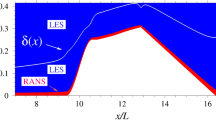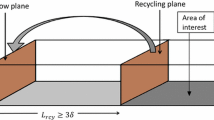Abstract
Large-eddy simulations of the neutrally stratified flow over the Askervein Hill were performed, to improve the knowledge of the flow obtained from field measurements and numerical simulations with Reynolds averaged Navier-Stokes (RANS) methods. A Lagrangian dynamic subgrid model was used but, to avoid the underdissipative character near the ground, it was merged with a damped Smagorinsky model. Simulations of a flat boundary-layer flow with this subgrid model showed that the turbulent vertical motions and shear stress were better resolved using grids with a stream to spanwise aspect ratio Δx / Δy = 2 than with an aspect ratio Δx / Δy = 1. Regarding the flow over the Askervein Hill, it was found that large-eddy simulations provide an acceptable solution for the mean-velocity field and better predictions of the turbulent kinetic energy in the upstream side of the hill than the \(k - \varepsilon\) model. However, as with the \(k - \varepsilon\) model, grid convergence was not achieved in the lee side and the size of the zone with reversed flow increased with the grid refinement. Nevertheless, the existence of the intermittent separation predicted with unsteady RANS in part one of this work seems unquestionable, due to the deceleration of the flow. In our opinion, a better modelling of the decelerating boundary layer in the lee side is required to improve the results obtained using equilibrium assumptions and achieve grid convergence.
Similar content being viewed by others
References
Allen T and Brown A (2002). Large-eddy simulation of turbulent separated flow over rough hills. Boundary-Layer. Meteorol 102: 177–198
Armenio V and Piomelli U (2000). A lagrangian mixed subgrid-scale model in generalized coordinates. Flow, Turbul Combust 65: 51–81
Baggett J (1998) On the feasibility of merging LES with RANS for the near-wall region of attached turbulent flows. Center Turbul Res, Stanford Univ, Calif, pp 267–277
Balaras E, Benocci C and Piomelli U (1995). Finite difference computations of high Reynolds number flows using the dynamic subgrid-scale model. Theor Comp Fluid Dyn 7: 207–216
Bou-Zeid E, Meneveau C and Parlange M (2005). A scale-dependent lagrangian dynamic model for large eddy simulation of complex turbulent flows. Phys Fluids 17: 025105
Carpenter M, Kennedy C (1994) Fourth-order 2N-storage Runge-Kutta schemes. Technical Report NASA-TM-109112, NASA Langley Research Center, 17 pp
Castro F, Palma JMLM, Silva Lopes A (2003) Simulation of the askervein flow. Part 1: Reynolds averaged Navier–Stokes Equations. (\(k-\epsilon\) turbulence model). Boundary-Layer Meteorol 107: 501–530
Chapman D (1979). Computational aerodynamics, development and outlook. AIAA J 17: 1293–1313
Davidson L, Peng S (2003) Hybrid LES-RANS modelling: a one-equation SGS model combined with a \(k-\epsilon\) model for predicting recirculating flows. Int J Numer Meth Fl 43: 1003–1018
Germano M, Piomelli U, Moin P and Cabot W (1991). A dynamic subgrid-scale eddy viscosity model. Phys Fluids A 3: 1760–1765
Hamba F (2003). A hybrid RANS/LES simulation of turbulent channel flow. Theor Comp Fluid Dyn 16: 387–403
Hunt J, Leibovich S and Richards K (1988). Turbulent shear flows over low hills. Quart J Roy Meteorol Soc 114(484): 1435–1470
Jordan S (1999). A large-eddy simulation methodology in generalized curvilinear coordinates. J Comput Phys 148: 322–340
Keating A and Piomelli U (2006). A dynamic stochastic forcing method as a wall-layer model for large-eddy simulation. J Turbul 7(12): 1–24
Keating A, Piomelli U, Balaras E and Kaltenbach H-J (2004). A priori and a posteriori tests of inflow conditions for large-eddy simulation. Phys Fluids 16: 4696–4712
Kim H and Patel V (2000). Test of turbulence models for wind flow over terrain with separation and recirculation. Boundary-Layer Meteorol 94: 5–21
Kim J and Moin P (1985). Application of a fractional-step method to incompressible Navier-Stokes equations. J Comput Phys 59: 308–323
Leonard A (1974). Energy cascade in large-eddy simulations of turbulent fluid flows. Adv Geophys 18: 237–248
Lund T, Wu X and Squires K (1998). Generation of turbulent inflow data for spatially-developing boundary-layer simulations. J Comput Phys 140: 233–258
Marusic I, Kunkel G and Porté-Agel F (2001). Experimental study of wall boundary conditions for large-eddy simulation. J Fluid Mech 446: 309–320
Mason P and Brown A (1994). The sensitivity of large-eddy simulations of turbulent shear flow to subgrid models. Boundary-Layer Meteorol 70: 133–150
Mason P and Thomson D (1992). Stochastic backscatter in large-eddy simulations of boundary layers. J Fluid Mech 242: 51–78
Meneveau C, Lund T and Cabot W (1996). A lagrangian dynamic subgrid-scale model of turbulence. J Fluid Mech 319: 353–385
Mickle R, Cook N, Hoff A, Jensen N, Salmon J, Taylor P, Tetzlaff G and Teunissen H (1988). The Askervein Hill Project: vertical profiles of wind and turbulence. Boundary-Layer Meteorol 43: 143–169
Nakayama A, Sakio K (2002) simulation of flows over wavy rough boundaries. Center Turbul Res, Stanford Univ, Calif, pp 313–324.
Nikitin N, Nicoud F, Wasistho B, Squires K and Spalart P (2000). An approach to wall modeling in large-eddy simulations. Phys Fluids 12: 1629–1632
Patel V (1965). Calibration of the Preston tube and limitations on its use in pressure gradients. J Fluid Mech 23: 185–208
Piomelli U, Moin P and Ferziger J (1988). Model consistency in large eddy simulation of turbulent channel flows. Phys Fluids 31: 1884–1891
Porté-Agel F, Meneveau C and Parlange M (2000). A scale-dependent dynamic model for large-eddy simulation: application to a neutral atmospheric boundary layer. J Fluid Mech 415: 261–284
Raithby G, Stubley G and Taylor P (1987). The Askervein Hill Project: a finite control volume prediction on three-dimensional flows over the hill. Boundary-Layer Meteorol 39: 247–267
Silva Lopes A and Palma JMLM (2002). Simulations of isotropic turbulence using a non-orthogonal grid system. J Comput Phys 175: 713–738
Silva Lopes A, Piomelli U and Palma JMLM (2006). Large-eddy simulation of the flow in an S-duct. J Turbul 7(11): 1–24
Smagorinsky J (1963). General circulation experiments with the primitive equations. I: the basic experiment. Mon Weather Rev 91: 99–164
Stoll R and Porté-Agel F (2006). Effect of roughness on surface boundary conditions for large-eddy simulation. Boundary-Layer Meteorol 118: 169–187
Stone H (1968). Iterative solution of implicit approximations of multidimensional partial differential equations. SIAM J Numer Anal 5: 530–558
Stull R (1988) An introduction to boundary layer meteorology, atmospheric sciences library. Kluwer Academic Publishers, Dordrecht 666 pp.
Taylor P, Teunissen H (1983) Askervein ’82: report on the September/October 1982 experiment to study boundary layer flow over Askervein, South Uist. Technical Report MSRS-83-8, Meteorological Services Research Branch, Atmospheric Environment Service, Downsview, Ontario, Canada, 172 pp. Available on-line at http://www.yorku.ca/pat/research/Askervein/ASK82.pdf
Taylor P, Teunissen H (1985) The Askervein Hill Project: report on the September/October 1983, main field experiment. Technical Report MSRS-84-6, Meteorological Services Research Branch, Atmospheric Environment Service, Downsview, Ontario, Canada, 300 pp. Available on-line at http://www.yorku.ca/pat/research/Askervein/ASK83.pdf .
Walmsley J and Taylor P (1996). Boundary-layer flow over topography: impacts of the Askervein study Boundary-Layer. Meteorol 78: 291–320
Wood N (2000). Wind flow over complex terrain: a historical perspective and the prospect for large-eddy modelling. Boundary-Layer Meteorol 96: 11–32
Zeman O and Jensen N (1987). Modification of turbulence characteristics in flow over hills. Quart J Roy Meteorol Soc 113: 55–80
Zhang Y, Street R and Koseff R (1994). A non-staggered grid, fractional step method for time-dependent incompressible Navier-Stokes equations in curvilinear coordinates. J Comput Phys 114: 18–33
Author information
Authors and Affiliations
Corresponding author
Rights and permissions
About this article
Cite this article
Silva Lopes, A., Palma, J.M.L.M. & Castro, F.A. Simulation of the Askervein flow. Part 2: Large-eddy simulations. Boundary-Layer Meteorol 125, 85–108 (2007). https://doi.org/10.1007/s10546-007-9195-4
Received:
Accepted:
Published:
Issue Date:
DOI: https://doi.org/10.1007/s10546-007-9195-4




